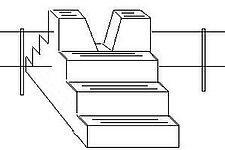Collinstown
- This article is about the Collinstown Baile na gCailleach. For other meanings, see Collinstown (disambiguation).
Template:Infobox Irish Place Collinstown (or Baile na gCailleach in Irish) is an expanding village in County Westmeath, situated on the R395 regional road 18 kilometers northeast of the Westmeath county town of Mullingar.
Name
The old Irish name of this village, translated means town of the veiled women. In the past the town was referred to irreverently as town of the hags because there was once a convent established on the Nun's island of nearby Lough Lene. Collinstown was known in the past as Maypole.
It is in St. Mary's (Roman Catholic) which has a population of approximately 700.
Historical Interests

Collinstown: viewed from the south

Collinstown has been an inhabited area from pre-Christian times, as the presence of a multitude of Ringforts and other historic relics testifies. Though some are now overgrown they may be visited seen on the high ground surrounding Lough Lene. The area contains ancient burial-grounds associated with Saint Colman who was responsible for 7 early Christian cells, of which Lene and Carric, are in the vicinity of Collinstown. Christian mass paths, and styles by which pilgrims travelled on foot through fields to Sunday mass date date from the penal times. Turgesius the Viking had a fortress built upon the major Lough Lene Island nearby. These and other historical relics are clearly marked on the Ordinance Survey of Ireland (OSi) maps numbers 41 & 42.
West of Collinstown in the Ranaghan south-west of Lough Lene, are the remains of different ringforts. At least one of these is attributed to the Viking, Turgesius. From the high ground they overlook the lake and were easy to defend. Legend has it that Turgesius dwelled here before being killed by Máel Sechnaill mac Maíl Ruanaid. In addition to this fort, Turgesius also had another upon the biggest island of Lough Lene which still today bears his name, Turgesius Island.
Collinstown also has close historic links with the religious orders, the Irish name Baile na gCailleach associated with the convent on the second island on Lough Lene. Nearby, to the north is the village of Fore and the religious and monastic complex of Fore Abbey.
The ringforts and other recorded protected structures are marked with small turquoise circles here: Collinstown plan

The Lough Lene Bell
In 1882, the Royal Irish Academy was presented the Bell of Lough Lene by the Barbavila estate proprietor, Mr. William Barlow Smythe. The bell had been discovered in Lough Lene the previous year by a boy fishing for eels on Castle Island, which was owned by Smythe at the time.
Given the close proximity to the Fore Abbey, the estate owner Smythe concluded that the bell possibly belonged to the St Feichin Abbey; During the Viking and Anglo-Norman oppressions, it may have been transferred to Nun's Island, before being eventually being hidden upon Castle Island.
The Bell has a faint outline of the Christian Celtic cross upon opposing sides and has an ornamental peripheral border. Smythe pronounced that ornamentation was generally reserved for the cases or shrines for that era and was therefore most unusual. The bell appears similar to two other bells from that early Christian period. These had been found in Bangor, County Down in the year 1832, and another in Cashel, County Tipperary in 1849. Smythe, the Barbavila owner, believed that the Lough Lene Bell was contemporary to these bells which were believed to be from the 7th century, therefore supporting his theory that it was possible that it could have been a relic of St. Feichins. The Folklore Commission[citation needed] also hold an account of Kit "the Blade" Fagan's discovery of the bell, which consequentially triggered a local treasure hunt for further artifacts around Collinstown and Fore.
While the original Lough Lene Bell remains within the National Museum, a half sized replica holds a place of pride as the Ceann Comhairle's Bell in Dáil Éireann. This replica was presented to the Dáil in 1931 by the widow of Major Bryan Cooper, a former member of the House.
Barbavila Manor
Barbavilla Collinstown

Barbavilla Collinstown
During the last century, the Barbavila House & Estate provided employment in the area. Houses, farm buildings, and animal dwellings were built from stone for employees throughout the immediate surroundings of Barbavilla in and around Collinstown. These stone houses, the old school, and farm buildings are protected through local heritage conservation laws. The notable feature of these buildings of stone is the roofing tile baked from local red coloured clay, which was manufactured within the Barbavilla estate. Some of these remaining buildings are identified by the small moss-green circles [citation needed].
Barbavilla is now an industrial complex for automotive parts.
Sport Activities

Mini-Golf Collinstown
Bathing, Sailing, wind-surfing, for beginners, and authorised fishing, [1] jetty facilities are available at the Collinstown lake access point named locally as "The Cut" [2] about 2km north of the village.
The Pitch and putt club of Collinstown is is popular with many European tourists.
The most successful local sporting organisation is the Lough Lene Gaels Hurling club. The club has won the Westmeath Senior Hurling Championship on seven occasions since 1975 and have been runners-up on five occasions.
There is also the very active Ballycomoyle Gaelic football club in the area with a strong underage section.
Commerce & Industry
Since 1964, the IRALCO Irish Aluminum Company situated in the Barbavilla Estate have made automotive parts for major European car companies, employing personnel locally.
Other Industries: Goat cheese production, Electrical, Plumbing,
See also
External links
- Ballycomoyle GAA Club
- Lough Lene Communities
- Westmeath County Council
- Ordenance Survey of Ireland (maps no. 41 and no.42)
- Viking Ireland Network school project
- Lough Lene Monks Boat
- Associated L.Lene boat text
- Lough Lene Gaels
- St. Colman (Colman Mac Luachain 6th/7th century)
- Betha Colmáin Maic Lúacháin, or, The Life of Colmán son of Lúachan
- Collinstown
